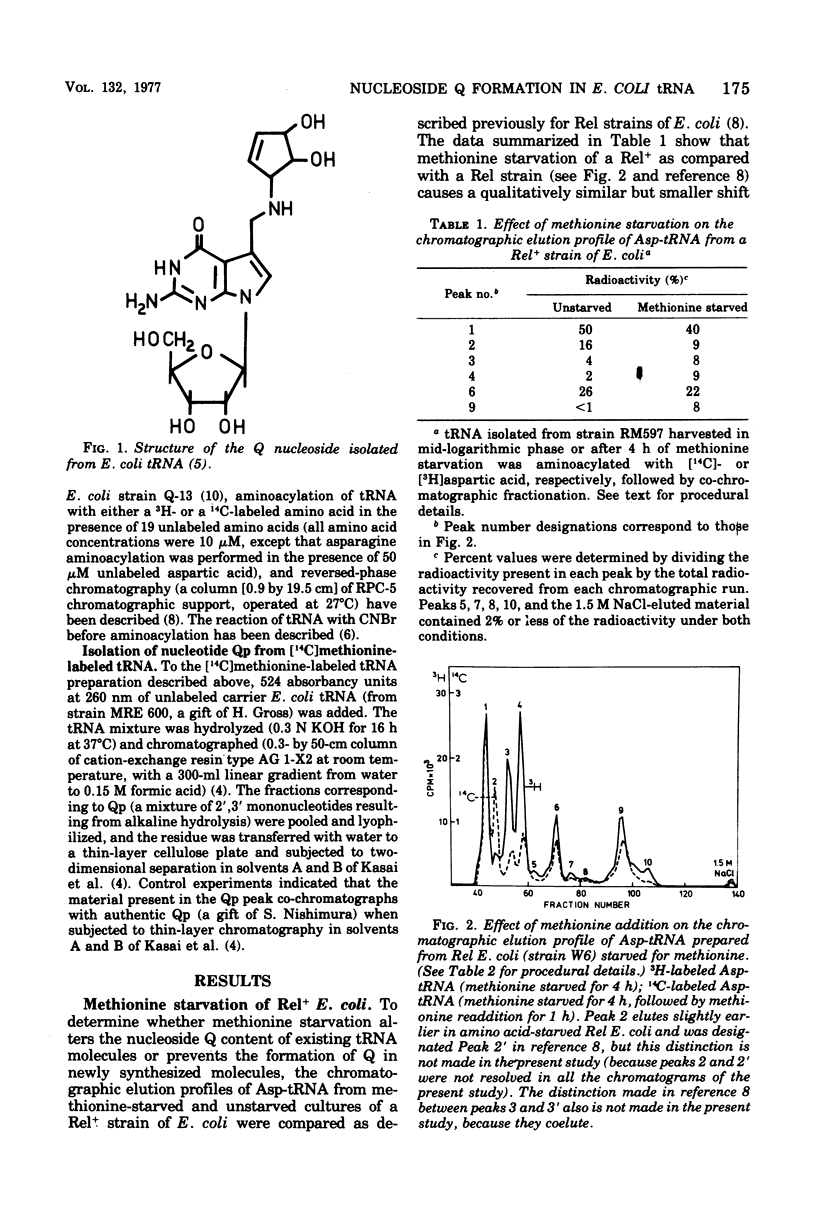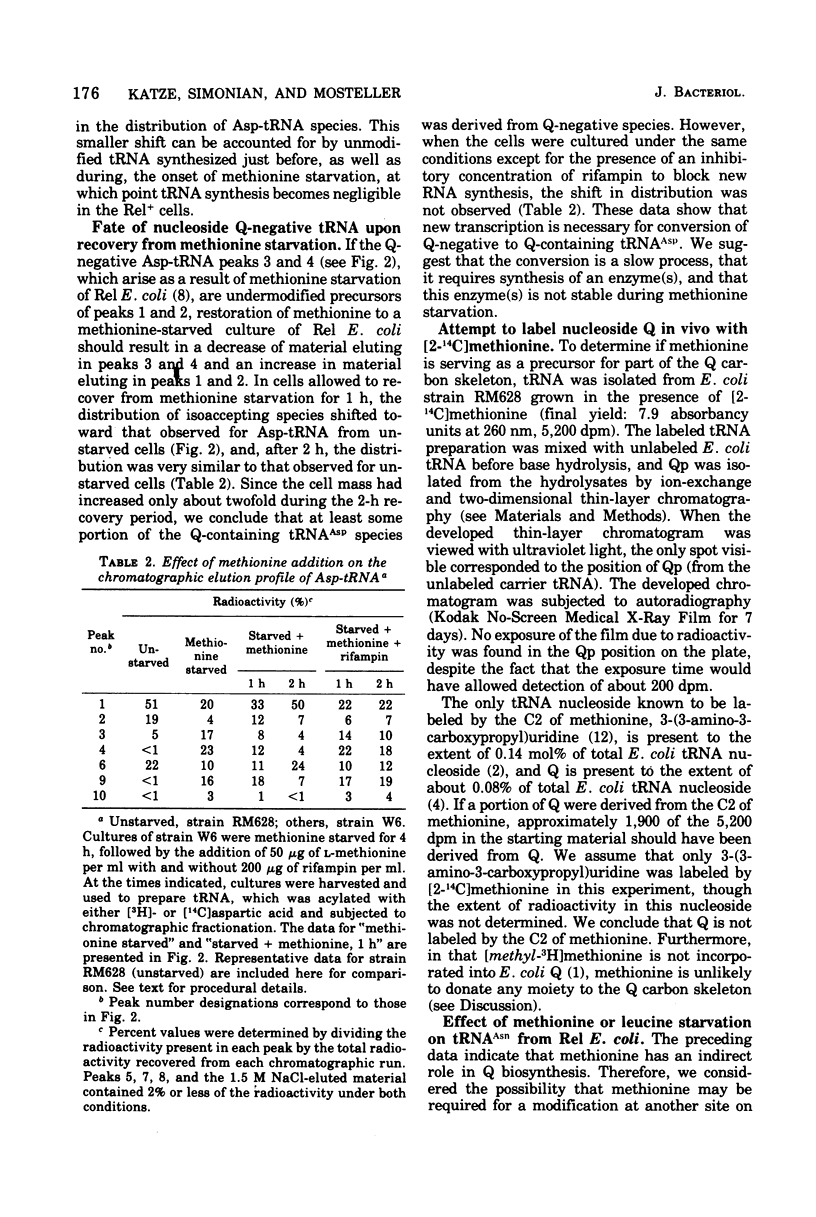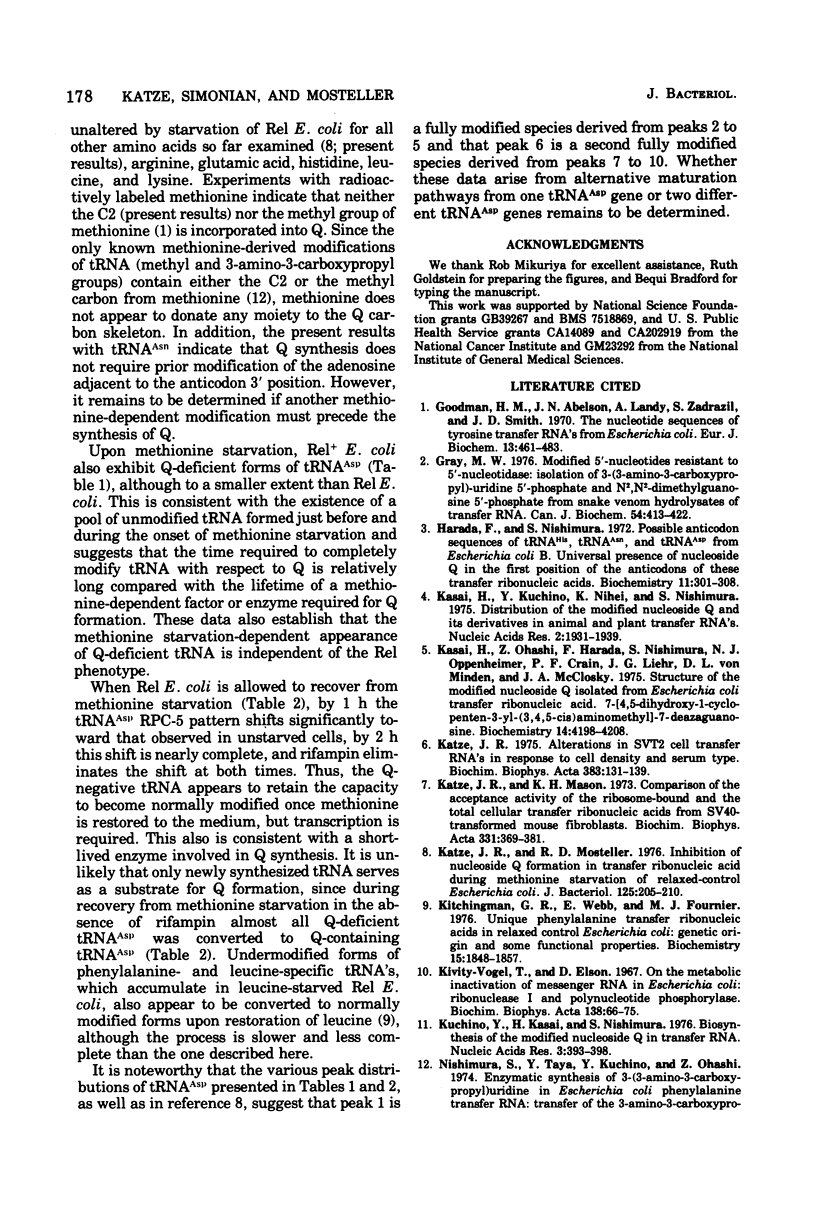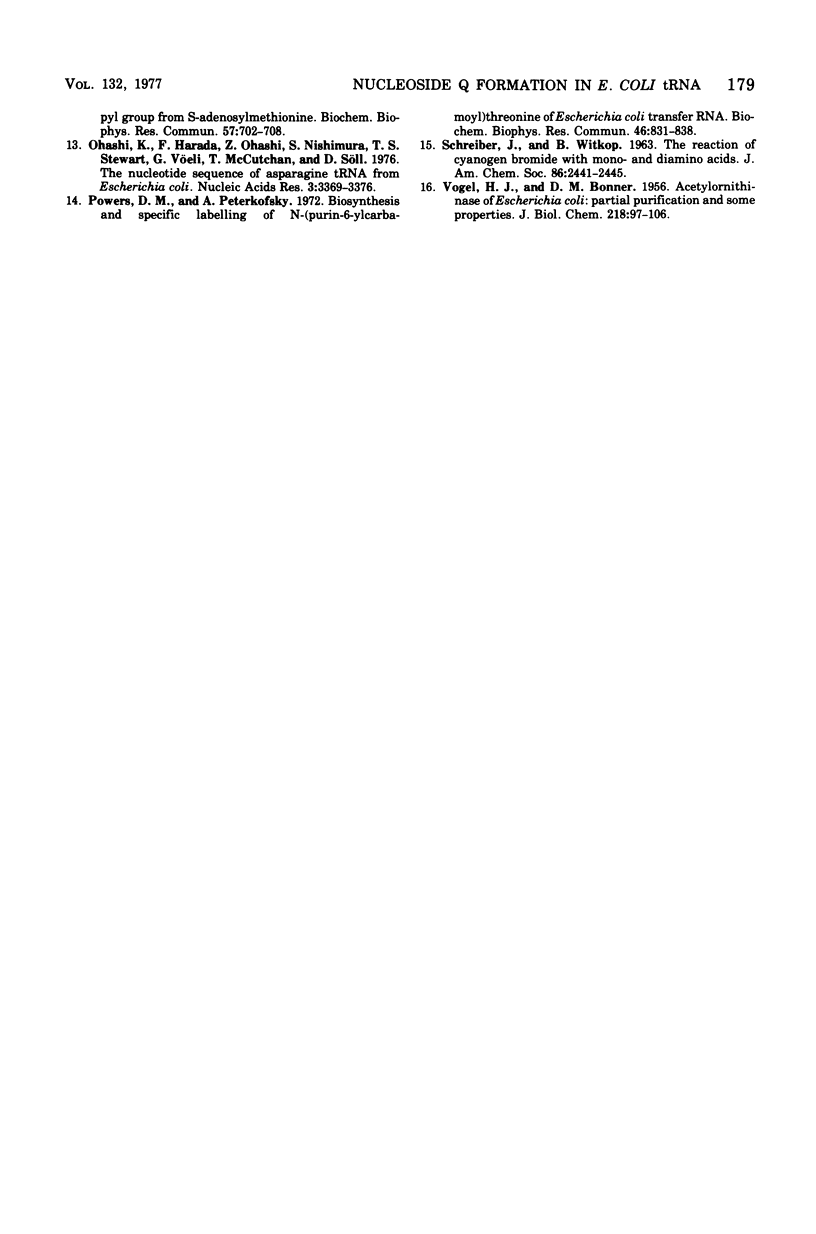Abstract
Previously, we reported that starvation of Rel Escherichia coli for methionine, but not leucine or histidine, results in chromatographically unique species of aspartyl-specific transfer ribonucleic acid (tRNAAsp) lacking the modified nucleoside Q. The present studies demonstrate that methionine starvation of Rel+ E. coli yields a qualitatively similar, but less pronounced, effect. Furthermore, during recovery from methionine starvation in Rel E. coli, the chromatographic elution pattern of tRNAAsp shifts towards that observed for unstarved cells after 1 h of recovery, and the shift appears complete after 2 h of recovery. This shift is inhibited by rifampin. Incorporation of [2-14C]methionine or [methyl-3H]methionine into growing cells of E. coli does not result in labeling of nucleoside Q. We interpret these findings to indicate that methionine has an indirect role in Q formation and that Q-deficient tRNA can be modified slowly to contain Q but that transcription is required. The chromatographic elution patterns of tRNAAsp from Rel E. coli starved for arginine, lysine, or glutamic acid indicate that these amino acids are not the source of the three- or five-carbon sequences in the modified portion of Q.
Full text
PDF





Selected References
These references are in PubMed. This may not be the complete list of references from this article.
- Goodman H. M., Abelson J. N., Landy A., Zadrazil S., Smith J. D. The nucleotide sequences of tyrosine transfer RNAs of Escherichia coli. Eur J Biochem. 1970 Apr;13(3):461–483. doi: 10.1111/j.1432-1033.1970.tb00950.x. [DOI] [PubMed] [Google Scholar]
- Gray M. W. Modified 5'-nucleotides resistant to 5'-nucleotidase: isolation of 3-(3-amino-3-carboxypropyl) uridine 5'-phosphate and N2, N2-dimethylguanosine 5'-phosphate from snake venom hydrolysates of transfer RNA. Can J Biochem. 1976 May;54(5):413–422. doi: 10.1139/o76-060. [DOI] [PubMed] [Google Scholar]
- Harada F., Nishimura S. Possible anticodon sequences of tRNA His , tRNA Asm , and tRNA Asp from Escherichia coli B. Universal presence of nucleoside Q in the first postion of the anticondons of these transfer ribonucleic acids. Biochemistry. 1972 Jan 18;11(2):301–308. doi: 10.1021/bi00752a024. [DOI] [PubMed] [Google Scholar]
- Kasai H., Kuchino Y., Nihei K., Nishimura S. Distribution of the modified nucleoside Q and its derivatives in animal and plant transfer RNA's. Nucleic Acids Res. 1975 Oct;2(10):1931–1939. doi: 10.1093/nar/2.10.1931. [DOI] [PMC free article] [PubMed] [Google Scholar]
- Kasai H., Oashi Z., Harada F., Nishimura S., Oppenheimer N. J., Crain P. F., Liehr J. G., von Minden D. L., McCloskey J. A. Structure of the modified nucleoside Q isolated from Escherichia coli transfer ribonucleic acid. 7-(4,5-cis-Dihydroxy-1-cyclopenten-3-ylaminomethyl)-7-deazaguanosine. Biochemistry. 1975 Sep 23;14(19):4198–4208. doi: 10.1021/bi00690a008. [DOI] [PubMed] [Google Scholar]
- Katze J. R. Alterations in SVT2 cell transfer RNAs in response to cell density and serum type. Biochim Biophys Acta. 1975 Mar 10;383(2):131–139. doi: 10.1016/0005-2787(75)90254-3. [DOI] [PubMed] [Google Scholar]
- Katze J. R., Mason K. H. Comparison of the acceptance activity of the ribosome-bound and the total cellular transfer ribonucleic acids from SV40-transformed mouse fibroblasts. Biochim Biophys Acta. 1973 Dec 21;331(3):369–381. doi: 10.1016/0005-2787(73)90023-3. [DOI] [PubMed] [Google Scholar]
- Katze J. R., Mosteller R. D. Inhibition of nucleoside Q formation in transfer ribonucleic acid during methionine starvation of relaxed-control Escherichia coli. J Bacteriol. 1976 Jan;125(1):205–210. doi: 10.1128/jb.125.1.205-210.1976. [DOI] [PMC free article] [PubMed] [Google Scholar]
- Kitchingman G. R., Webb E., Fournier M. J. Unique phenylalanine transfer ribonucleic acids in relaxed control Escherichia coli: genetic origin and some functional properties. Biochemistry. 1976 May 4;15(9):1848–1857. doi: 10.1021/bi00654a010. [DOI] [PubMed] [Google Scholar]
- Kivity-Vogel T., Elson D. On the metabolic inactivation of messenger RNA in Escherichia coli: ribonuclease I and polynucleotide phosphorylase. Biochim Biophys Acta. 1967 Mar 29;138(1):66–75. doi: 10.1016/0005-2787(67)90586-2. [DOI] [PubMed] [Google Scholar]
- Kuchino Y., Kasai H., Nihei K., Nishimura S. Biosynthesis of the modified nucleoside Q in transfer RNA. Nucleic Acids Res. 1976 Feb;3(2):393–398. doi: 10.1093/nar/3.2.393. [DOI] [PMC free article] [PubMed] [Google Scholar]
- Nishimura S., Taya Y., Kuchino Y., Oashi Z. Enzymatic synthesis of 3-(3-amino-3-carboxypropyl)uridine in Escherichia coli phenylalanine transfer RNA: transfer of the 3-amino-acid-3-carboxypropyl group from S-adenosylmethionine. Biochem Biophys Res Commun. 1974 Apr 8;57(3):702–708. doi: 10.1016/0006-291x(74)90603-2. [DOI] [PubMed] [Google Scholar]
- Ohashi K., Harada F., Ohashi Z., Nishimura S., Stewart T. S., Vogeli G., McCutchan T., Soll D. The nucleotide sequence of asparagine tRNA from Escherichia coli. Nucleic Acids Res. 1976 Dec;3(12):3369–3376. doi: 10.1093/nar/3.12.3369. [DOI] [PMC free article] [PubMed] [Google Scholar]
- Powers D. M., Peterkofsky A. Biosynthesis and specific labeling of N-(purin-6-ylcarbamoyl)threonine of Escherichia coli transfer RNA. Biochem Biophys Res Commun. 1972 Jan 31;46(2):831–838. doi: 10.1016/s0006-291x(72)80216-x. [DOI] [PubMed] [Google Scholar]
- VOGEL H. J., BONNER D. M. Acetylornithinase of Escherichia coli: partial purification and some properties. J Biol Chem. 1956 Jan;218(1):97–106. [PubMed] [Google Scholar]


